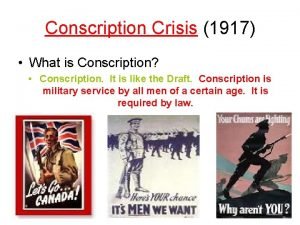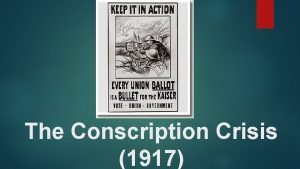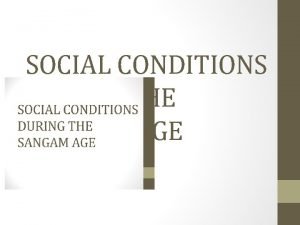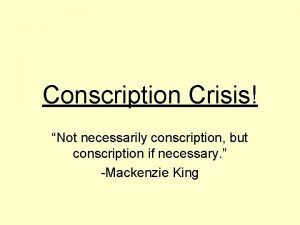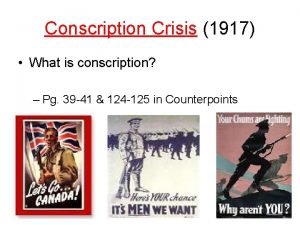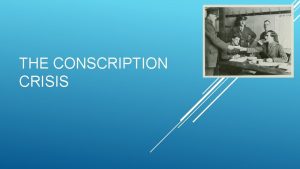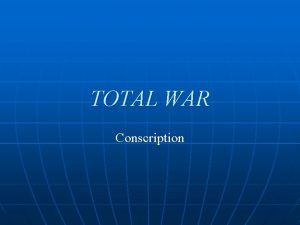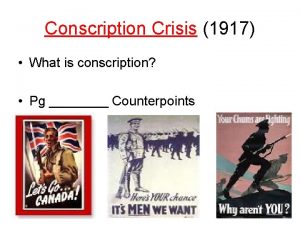How effective were recruitment and conscription during the












- Slides: 12

How effective were recruitment and conscription during the First World War?

Learning objective – to be able to assess the impact of recruitment and conscription during the First World War. I can describe some of the ways people were conscripted and recruited during the First World War. Grade D I can explain the impact conscription and recruitment during the First World War. Grade B I can explain and evaluate the impact of conscription and recruitment during the First World War. Grade A

Starter – How many men were recruited to fight in the British Army in the first month of the First World War?

Starter – How many men were recruited to fight in the British Army in the first month of the First World War? 175, 000 men were recruited to fight in the British Army between August and September 1914.

Why did so many people want to join up and fight in the British army? There was already strong anti. German feeling in Britain in 1914. Men were anxious to do their bit and not get ‘left out of the fun’. The British press fuelled this hatred by regularly reporting stories of German atrocities – such as babies being butchered in Belgium and that the Germans made soap from boiling corpses.

How did Pals Battalions encourage men to join up? Britain had a much smaller army than Germany and Lord Kitchener, Secretary of State for War, was put in charge of recruiting 100, 000 men to fight. Kitchener was enormously successful in doing this and one of the reasons why was that volunteers were organised into battalions from other volunteers from the same town. This meant you could be serving with your friends and people from the same area as you. This also added pressure for men to join up as many did not want to look unpatriotic compared with their neighbours.

What was the impact of Pals Battalions? Pals Battalions were a huge factor in the recruitment drive which saw 100, 000 men volunteer per month between September 1914 and September 1915. Many Pals Battalions developed close bonds and this ensured morale stayed high. However, the downside was that in the fighting Pals Battalions were wiped out or suffered heavy losses. This meant that some communities back home were severely depleted.

What was the Derby Scheme? The heavy losses of 1915, meant that by the end of the year, numbers of volunteers went down sharply. The government set up a National Register of men aged between 15 -65. Using this, the ‘Derby Scheme’ was set up which asked men to promise to join up if they were asked, with single men being asked first. This was very unpopular with less than half the men in the country agreeing to join the scheme.

Why was conscription introduced? The numbers of volunteers were falling by December 1915 in the face of the need for more troops. Only 55, 000 men volunteered in December – half the average volunteer number per month since the beginning of the war. The volunteer system was seen as unfair and not all parts of society were taking an equal share of the burden. Volunteers came often from workers from such industries as mining and farming – this damaged the output of these essential industries.

How was conscription introduced? The Military Service Act was passed in January 1916. It said that all single men aged between 18 and 41 could be called up. This was supported by a second Military Service Act in May 1916 which extended call-ups to married men in the same age group.

Main tasks Define the following terms and features – - Pals Battalions. Derby Scheme. The Military Service Acts. Recruitment. Conscription. Complete the two source analysis sheets on recruitment posters and then answer the following questions – �What similarities do the posters have? Explain your answer. �What differences do the posters have? Explain your answer.

Choose your own plenary To show much progress you have made this lesson, choose any of the following plenaries to complete and share with the rest of the class. You can do as many of these activities as you like. �Tweet my lesson- no more than 140 characters. �Write a Facebook status for a person who is signing up to join the British Army in September 1914 and then another who is being conscripted in July 1916. �Choose five words that sum up what you have learnt this lesson and explain why you have chosen them. Your chosen words must all start with the same letter.
 Pros and cons of conscription ww1
Pros and cons of conscription ww1 Recuritment meaning
Recuritment meaning What was the conscription crisis of 1917
What was the conscription crisis of 1917 Conscription crisis 1917
Conscription crisis 1917 Future in the past was were going to examples
Future in the past was were going to examples Dinosaur were reptiles that lived
Dinosaur were reptiles that lived Who were the vellalars during the sangam age
Who were the vellalars during the sangam age Reasons for exploration 3 g's
Reasons for exploration 3 g's Wall street crash of 1929
Wall street crash of 1929 Hình ảnh bộ gõ cơ thể búng tay
Hình ảnh bộ gõ cơ thể búng tay Lp html
Lp html Bổ thể
Bổ thể Tỉ lệ cơ thể trẻ em
Tỉ lệ cơ thể trẻ em


